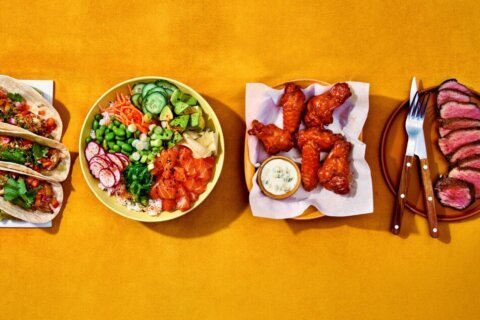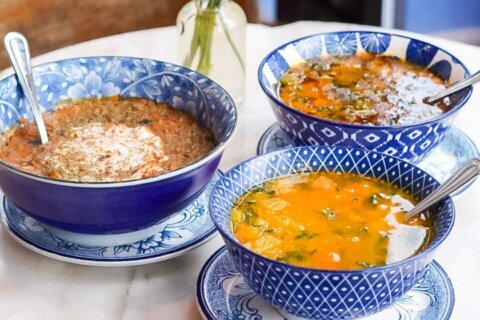When I was growing up, everyone ate PB&J sandwiches and an apple for lunch. Today’s lunch boxes (or recyclable bags) look a lot different — especially for kids like my own who have no interest in sandwiches. Whether your kids simply don’t like sandwiches or can’t eat them because they’re allergic to peanut butter or have celiac disease, here are some guidelines for packing a lunch that’s healthy, balanced and appealing:
1. Prep fruit and vegetables.
You don’t need to be a nutritionist to know that most Americans should be eating more fruit and veggies. In fact, current recommendations suggest that half of your meals comprise of produce. That translates to 2 to 6 cups of fruit and vegetables per day, depending on your age, gender and caloric needs.
So, try to include at least one fruit and one vegetable in your child’s lunch. To avoid forgetting these items at 6 a.m., prep some nonperishable options like dried fruit ahead of time. For example, on Sunday night, separate servings of dried apricots into snack-size bags so you can throw them into a lunch box with little thought later in the week.
[See: 10 of the Biggest Health Threats Facing Your Kids This School Year.]
2. Pack protein.
Most people don’t have a particularly difficult time getting the recommended daily allowances of protein — and that’s a good thing since the nutrient is especially critical for active, growing kids. The tricky thing about protein is that the foods that are highest in it tend to also be high in fat and don’t necessarily package well for a kid’s lunch (think a juicy steak). Other default options like deli meat lend themselves to be eaten between two slices of bread.
So, if you’re avoiding sandwiches, try some less-conventional options while keeping in mind that most kids need 4 to 6 ounces of protein per day. One tablespoon of peanut butter (which travels well in Tupperware or can be bought pre-packaged), one egg, 12 almonds, one serving of Greek yogurt (depending on the type) and 2 tablespoons of hummus are considered equivalent to 1 ounce of protein.
3. Count carbs.
Carbohydrates and starchy foods are easy to pack in a lunch, and I often have a hard time limiting them when I’m making my kids’ lunches. They like and they eat carbs, but I try to only provide one option because there are so many opportunities to get carbs throughout the day (and, if your kids are like mine, their breakfasts likely consist primarily of carbs). In fact, pizza, pasta and grain-based desserts are among the top 25 sources of caloric intake for most kids, so it’s pretty easy to meet the recommendation that half of our daily calories come from carbs. Lunch-friendly, relatively healthy options include foods such as rice cakes and whole-wheat pita bread.
[See: 13 Tips for Getting Your Kids Ready for Back to School.]
So, try this approach: Fill your child’s lunch with one food from each list below. Then, add a fifth item. It’s what I think of as the “five things lunch.” If you do some prep or buy serving-size packages of some of these foods, packing a lunch can be as easy as assembling five things in five minutes. Just keep in mind that foods rich in protein and dairy are nutritionally dense, but they also tend to be relatively high in fat.
Fruit
— Apple (cut in pieces and spritzed with lemon)
— Dried apricots or other dried fruit (pre-sorted in plastic bags)
— Freeze-dried fruit or other “preserved” fruit like banana chips
— Frozen fruit (to mix with yogurt since it will defrost by lunch)
— Berries or grapes (pre-washed and bagged, or packed in Tupperware)
— Watermelon or other melon (when in season; pre-cut and bagged)
— Applesauce (in a pouch or container; look for low-sugar options)
— Mandarin oranges
Vegetable
— Edamame (served cold or kept warm in a thermos; also high in protein)
— Baby carrots or mini bell peppers (packaged ahead of time and offered with ranch or hummus)
— Celery sticks (prepared with peanut butter or other dip)
— Salad greens (set aside from dinner the night before; offered with dressing)
— Cucumber “chips” (sliced, prepped and salted ahead of time)
— Peas (seasoned with salt and packaged in Tupperware; counts as protein, too)
Protein/Dairy
— Peanut butter (served as a dip for a fruit, vegetable or pretzels)
— String cheese
— Yogurt (preferably Greek; look for low-sugar options)
— Almonds, cashews or other nut (served in a small portion)
— Chicken or other lean meat (saved from dinner)
— Tuna fish (bought in a serving size and served as a spread)
— Hard-boiled egg (stored in Tupperware)
[See: High-Protein Breakfast Ideas.]
Carbohydrate
— Pretzels
— Whole-wheat pita (to dip in peanut butter or stuff with lean meat)
— Rice cakes (spread with peanut or apple butter)
— Whole-wheat bagel (with light dip or spread)
— Popcorn
— Homemade or healthy store-bought muffin (ideally made with fruit)
— Whole-wheat tortilla (for wraps)
More from U.S. News
5 Unintended Consequences of Eating Too Much Protein
What’s Really in Those Meatless Meats?
Healthy Substitutes for Mayonnaise
More Than 100 Healthy School Lunch Ideas That Don’t Involve a Sandwich originally appeared on usnews.com







